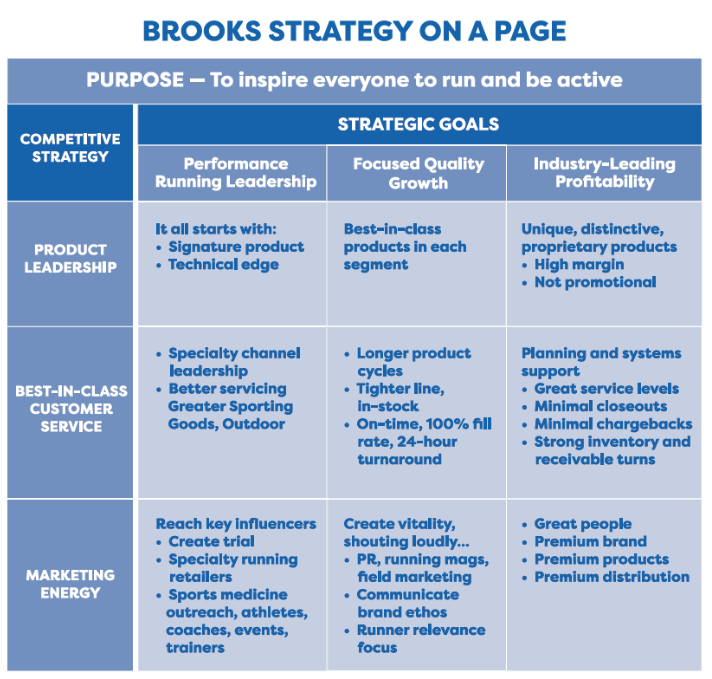Excerpt from Running with Purpose: How Brooks Outpaced Goliath Competitors to Lead the Pack by Jim Weber
Brooks would need more than focus and a few great products if it was going to be an authentic brand. We needed an expressed purpose for a brand that had been founded a hundred years earlier and was now refounded in a new century with a new focus and business discipline. A North Star for everything we would do.
When I arrived, there was a mission statement on the wall in the main conference room. It said that Brooks would become a leader in performance running and one of the most admired companies in the world. To me, a mission was like a campaign—useful for setting company goals, but it often had a beginning, a middle, and an end. Thinking further on it, to be an admired company is aspirational, but as measured and recognized by whom? Often the “admired company” lists either overemphasize current financial performance or are derivative of a beauty contest influenced by “best companies to work for” lists. In addition, being admired is external recognition of outcomes; it does not shine a light on how to actually create those “admired” results. We decided that a purpose was preferable to a mission. Purpose is a forever cause that can permeate everything from the business to the brand to the culture. It is a choice, not an outcome. As people came to know Brooks, our purpose would be evident at our core, and we could clearly communicate it to the world as our reason for being—our North Star.

With our new, exclusive focus on building gear for runners and selling it where they shopped, I turned to our team members to brainstorm the articulation of our purpose. We held meetings with groups of twelve employees at a time to engage them in why Brooks existed and what our purpose was. At one such meeting, we gathered in the Chariot conference room at our headquarters in Bothell. We discussed how the leading gear brands in athletic and outdoor were centered on aspirational, epic achievement: breaking the tape, standing on the podium, summitting the mountain. They also featured athletes at the pinnacle of their sport whom everyone else could emulate. I think everyone at Brooks instinctively knew we were different. Brooks was about you and your run. Our point of view was runner to runner, human to human. Every runner, every human. Whether it was your tenth marathon or your first 5K, whether you finished on the podium or at the back of the pack, we were building product for you and cheering you on your run.
We were getting close to defining a North Star. Nike dominated the run category, and its “Just Do It” call to action was understood by every person who ever competed in a sport. Nike and other brands featured epic athletic achievement and aspirational messaging. Break the tape. Take the gold. “Be like Mike.” It was easy to look up in awe at these athletes.
We knew there was a Brooks position that was different, but every bit as compelling, universal, and timeless. We thought Brooks’s purpose could occupy a more personal, runner-to-runner ethos that was more accessible and motivational. Was it a call to action like “Run Happy” or “Run, World, Run”? Did we have the stature as a brand to suggest a call to action? Was it better to commit ourselves to an internal call to action and earn runners’ support over time?

During yet another of these meetings, I was sitting across the table from one of our marketing managers who inserted the word “inspire” into the conversation. The group discussed how runners need inspiration to begin, to persist, to finish, and to accomplish goals. Inspiration is needed every day, every run, every race. To commit as a brand to inspire would call on us to engage with customers rationally and emotionally. Being the leading brand or an admired company was simply an outcome; choosing to inspire runners was a commitment we could act on. Further, it challenged us to engage our chosen customers on the power of the run in their lives and elicit a response. So, we had the words, and not long after, we planted our flag on a singular purpose: to inspire everyone to run and be active.
We rooted our purpose in a truth we all instinctively knew: Running is a limitless source of positive energy that can transform a day, a life, and even the world. Our promise is to create the best running gear, tools, and experiences that move you along your path.
It was a unique position that I believed could define our brand, help us become the best at what we do, and stand the test of time. In every meeting, inside and outside the company, I began to present Brooks’s strategic approach on a single page (see figure below). More than twenty years later, we are still executing this strategy, although we have evolved with the runner, scaled it, and added digital distribution and communication pipes. At a glance, the chart reminds us of Brooks’s North Star: Our purpose is to inspire everyone to run and be active. That purpose guides our brand positioning, customer promise, and business model.

If the purpose answers why, our competitive strategies answer how we will compete and present to the customer, and our strategic goals describe what we will accomplish. Through product leadership, we design signature product that is the best in each segment and worth the price, leading to strong margins. We want to be the very best in customer service: achieving leadership in specialty run shops; distributing and fulfilling product on time, even if it means twenty-four-hour turnaround; and attaining tremendous service levels while we manage inventory risk. We bring marketing energy to everything we do, telling compelling stories and gaining the trust and affinity of the most discerning people in running: its key influencers. We knew if we could win the trust of influencers and frequent runners, they would be a stronger brand halo over the long term than a paid athlete or celebrity endorser.
This one-page strategy was tested quickly.
The Asics 2000 series was the best-selling shoe in the world during these years. We estimated they were selling as many as eight million pairs per year, which was huge. But beginning in 2002, Asics couldn’t keep up with demand. Meanwhile, our research and development team had made great progress on the redesign of our Adrenaline GTS, a support shoe that would go on to become a best seller. Pete Humphrey, who runs our research-and-development group, had been working with specialty running accounts to pinpoint what runners were looking for in the Adrenaline. Pete came to Brooks from the parent company of Reebok, Pentland Sports, where he had learned shoe design from Britain’s legendary cobblers and had honed his skills as a craftsman working with Premier League soccer players. For the Adrenaline, he led the progressive diagonal rollbar, which dramatically improves a runner’s motion path. He and his team conducted intensive analyses of runners’ pressure points inside his small but growing lab. From their research, we were able to biomechanically engineer a post at the medial arch that allows for progressive support and creates smoother transitions from the midstance phase to the propulsion phase. The Adrenaline GTS 4 was a breakthrough that would portend many future innovations.
We now had a great product and an opportunity to get it in front of more retailers and runners. Our strategy called on us to be the best in customer service and to have a 100 percent on-time fill rate. If Asics was sold out, we air-freighted the Adrenaline in every size and width. We were determined to chase demand and not miss an opportunity to gain market share with shoes on feet. Staying true to our purpose, we encouraged and serviced the retailer to bring out our Brooks Blue box. It was working. The Brooks flywheel was gaining momentum.

Running with Purpose tells the inside story of how Jim Weber stepped in to transform the Brooks culture to unify the company and lead them from last place to first, beating Nike, Adidas, Asics, New Balance – everyone. Available as:

